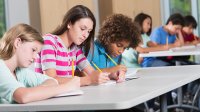ELA Activities to Start the School Year
A variety of options to help you learn about your students, their interests, and their writing abilities while fostering a classroom community.
At the beginning of the school year, it’s important to get to know your students as readers, writers, and speakers. It’s also important to build a classroom community. I start each year weaving in assignments that allow me to achieve these goals simultaneously while encouraging students to spend time self-reflecting. I complete each of the assignments myself and share my writing with students to provide a model of the assignment and allow my students to learn more about me.
Sharing my honest and imperfect writing examples helps develop trust. I invite students to share their writing with their peers and at times collaborate on assignments. This consistent sharing and collaboration help facilitate a classroom community where students feel safe sharing their ideas and enjoy working together.
These introductory writing activities also help students see themselves as writers right from the start. I design these assignments as flexible, low-stakes opportunities for success. As writing assignments become more complex throughout the school year, students move forward with confidence because they’ve already seen that they can be successful writers in our classroom.
Assignment Examples
Getting to know you paragraph: On the first day of school, I provide a list of questions that encourage students to share about themselves personally and as students. I ask them to use their answers to write a paragraph about themselves, choosing from this list of questions and sharing any additional information they’d like. This gives me instant insight about their writing style and ability as well as what they think about themselves. It also opens the door for them to share anything they’d like with me.
Here are some question examples:
- What are you looking forward to about school this year?
- What can I do to help you be successful this year?
- What do you enjoy doing outside of school?
- What movie has moved you the most and why?
- Who is your favorite character from a book you have read, and what is it that you liked about this character?
- Do you have a personality trait that gets you in trouble? Explain.
- Would you rather be a great musician, athlete, scientist, politician, entrepreneur, or writer? Explain.
Revealing story: Students brainstorm a list of personality traits, tendencies, pet peeves, and idiosyncrasies that make them who they are. Then they choose one trait they’re comfortable sharing with their peers and write a short narrative that describes a time in their life that reveals that chosen trait. Their story should showcase the trait without stating it explicitly. I invite students to share their stories and ask other students to guess what personality trait the writer is highlighting.
“Are you more like…?” Give students a list of opposing concepts and instruct them to circle which they’re most like from each pair. Then they choose one pair to write an extended metaphor that explains how they’re more like one than the other. Some example pairs are fire/ice, winter/summer, breakfast/dinner, filing cabinet/medicine cabinet, boat/airplane, etc.
Living history reflection: Students write a poem or paragraph that shows their thoughts, feelings, and/or questions about a significant historical event within their lifetime. I tell them that it should be something they remember clearly and that impacts them. This assignment provides insight into what’s important to them and how current events affect them, and creates an opportunity to discuss events that are significant to the students.
Book review in images and words: Students choose a book they enjoyed reading over the summer as part of our summer reading requirements and create a Google Slide to share their book review with their peers. The slide includes a photo of the book cover, has words and images that showcase significant aspects about the book, and explains why they enjoyed reading it. Students then present their slides to their peers, and during the presentations the audience makes a list of potential books they may want to read for their independent reading based on the reviews.
Image reflection: I give students various images of paintings and photographs, and they complete a quick write-up based on questions I give them.
Here are some question examples:
- What do you think people/animals are thinking and feeling in the image?
- Describe the setting, including what you think the time and place is in the image.
- How does the image make you feel?
- What do you imagine inspired the artist or photographer to capture this image?
- What questions do you have about the image?
Then students get into groups to combine their ideas and write a fictional account of what they imagine the story is behind the image, giving the people and/or animals thoughts, feelings, wants, etc.
After my students complete even some of these activities, I know a lot more about them as students and individuals and can use this information to design lessons that align with their needs and interests. They also build trust and create a positive classroom community.
